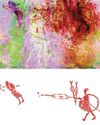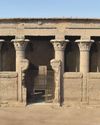Long regarded as a charlatan’s game, alchemy is now taking its proper place in the history of science.

In a light-filled room in a building behind the State Museum of Prehistory in Halle, Germany, a row of tables is lined with oddly shaped glass vessels. When Christian-Heinrich Wunderlich saw them for the first time three years ago, they were in thousands of pieces, enough to fill six crates. Archaeologists had discovered the fragments during a rescue excavation in nearby Wittenberg in a niche underneath what had been a fifteenth-century monastery’s basement stairway.
When the crates had first been brought to his lab, Wunderlich, who is the head of the Saxony-Anhalt State Office for Heritage Management and Archaeology’s restoration facility, assumed they contained centuries-old ordinary household garbage, likely broken drinking glasses and clay cookware, that had been swept up and forgotten. “At first we thought it was just a lot of glass,” Wunderlich recalls. “We noticed the weird shapes, and just shook our heads.”
A few of the most misshapen shards landed on Wunderlich’s desk. He noted that some were discolored and melted, as though they had been subjected to extreme heat. At least half were coated with curious residues—silvery crystals, for example, or thick, crusty red or brown layers. As Wunderlich pondered them, he began to wonder if there was something else to the story. He decided to pursue a hunch, scraping tiny bits of residue off one of the shards for chemical analysis. The results included the presence of copious antimony and antimony ore. “That’s when we understood that these were the tools of an alchemist,” he says.
This story is from the January/February 2016 edition of Archaeology.
Start your 7-day Magzter GOLD free trial to access thousands of curated premium stories, and 8,500+ magazines and newspapers.
Already a subscriber ? Sign In
This story is from the January/February 2016 edition of Archaeology.
Start your 7-day Magzter GOLD free trial to access thousands of curated premium stories, and 8,500+ magazines and newspapers.
Already a subscriber? Sign In

A Very Close Encounter
New research has shown that human figures painted in red on a rock art panel in central Montana depict individuals engaged in a life-or-death encounter during an especially fraught historical moment.

A Sword for the Ages
A zigzag pattern, now tinged with the green-blue patina of oxidized metal, adorns the octagonal hilt of a rare sword dating to the Middle Bronze Age in Germany (1600-1200 B.C.) that was recently excavated in the Bavarian town of Nördlingen.

Ancient Egyptian Astrology
For centuries, layers of soot have coated the ceilings and columns in the entrance hall of Egypt's Temple of Esna. Now, an Egyptian-German team of researchers, led by Hisham El-Leithy of the Egyptian Ministry of Tourism and Antiquities and Christian Leitz of the University of Tübingen, is restoring the temple's vibrant painted reliefs to their original brilliance.

BRONZE AGE POWER PLAYERS
How Hittite kings forged diplomatic ties with a shadowy Greek city-state

RITES OF REBELLION
Archaeologists unearth evidence of a 500-year-old resistance movement high in the Andes

Secrets of Egypt's Golden Boy
CT scans offer researchers a virtual look deep inside a mummy's coffin

When Lions Were King
Across the ancient world, people adopted the big cats as sacred symbols of power and protection

UKRAINE'S LOST CAPITAL
In 1708, Peter the Great destroyed Baturyn, a bastion of Cossack independence and culture

LAPAKAHI VILLAGE, HAWAII
Standing beside a cove on the northwest coast of the island of Hawaii, the fishing village of Lapakahi, which is surrounded by black lava stone walls, was once home to generations of fishers and farmers known throughout the archipelago for their mastery of la'au lapa'au, or the practice of traditional Hawaiian medicine. \"

A MORE COMFORTABLE RIDE
Although the date is much debated, most scholars believe people 5,000 years ago. For thousands of years after that, they did so without saddles. \"In comparison with horse riding, the development of saddles began relatively late, when riders began to care more about comfort and safety in addition to the horse's health,\" says University of Zurich archaeologist Patrick Wertmann.